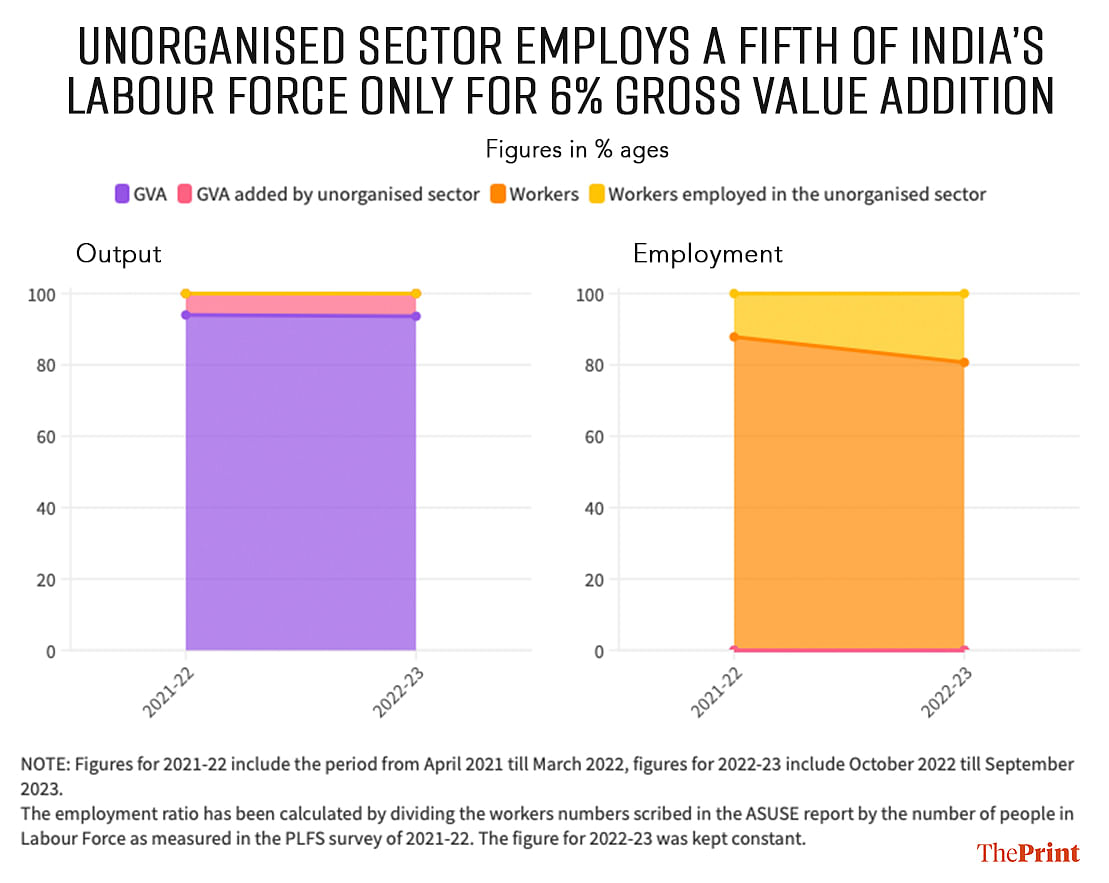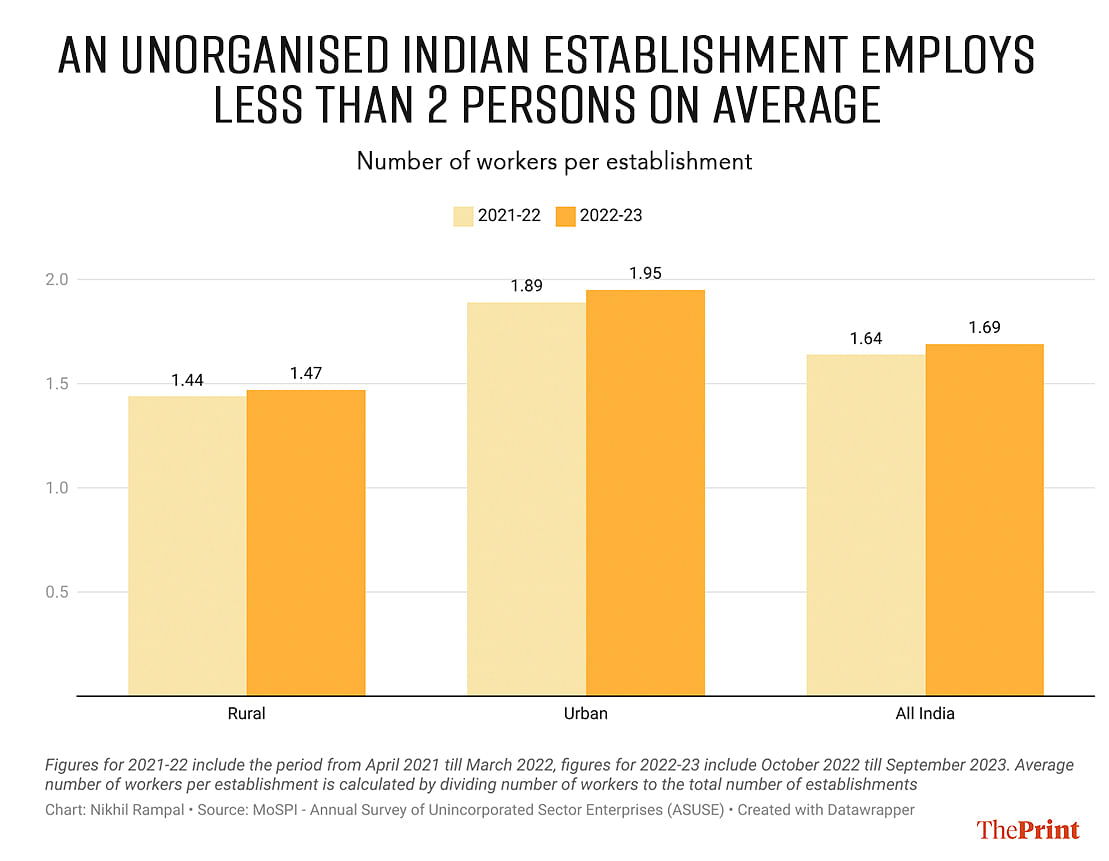Rome: Latest government data has revealed that two-thirds of India’s workforce is employed in very low-productivity jobs in the unorganised sector, contributing to the GDP at disproportionately low levels.
While the data on the agriculture sector is more readily available, the Ministry of Statistics and Programme Implementation (MoSPI) last week released a brief fact sheet summarising the results of its Annual Survey of Unincorporated Sector Enterprises (ASUSE) for 2021-22 and 2022-23, painting quite a grim picture.
India’s unorganised and non-agricultural sector overwhelmingly comprises tiny units employing less than two people on average, and their contribution is a little more than 6 percent of India’s gross domestic product (GDP) despite 19 percent of the country’s workforce employed with them, showed the data.
The survey covered over four lakh non-agriculture, non-incorporated establishments from April 2021 to March 2022 and October 2022 to September 2023.
The findings showed that India’s unorganised sector remains a vital part of the economy due to its high share in employing the workforce but that it is a highly fragmented and low-productivity sector.

ThePrint compared the unorganised sector’s gross value added figures with MoSPI’s GDP data for the overall economy in the relevant periods. The analysis showed that the unorganised sector’s contribution is just 6 percent of the GDP in 2022-23. In 2021-22, its contribution was 6.2 percent of the GDP.
The second analysis compared the ASUSE data on employment in the unorganised sector with MoSPI’s data on the overall labour force in the country — taken from its Periodic Labour Force Surveys. According to this analysis, 19 percent of India’s workforce of 56.7 crore people — 10.96 crore workers — remains employed in the non-agriculture, unorganised sector.
Separately, according to MoSPI’s data, the agriculture sector — largely unorganised — employs nearly 45 percent of India’s labour force but contributes just about 15 percent to the country’s GDP.
Together, the data shows that nearly two-thirds of India’s population remains employed in very low-productivity occupations.
Also read: Despite highest wages across India, Kerala’s young males are among most unemployed in the country
Too many firms offering too few jobs
The first key characteristic of the Indian unorganised sector is that there are a huge number of establishments, but these are tiny, so this number does not translate into jobs. According to the survey fact sheet, there were roughly 6.5 crore establishments with 10.96 crore workers in 2022-23.
This means the number of employees or workers in an unorganised non-agriculture setting does not average even two people per firm.

The first key characteristic of the Indian unorganised sector is that there are a huge number of establishments, but these are tiny, so this number does not translate into jobs. According to the survey fact sheet, there were roughly 6.5 crore establishments with 10.96 crore workers in 2022-23.
This means the number of employees or workers in an unorganised non-agriculture setting does not average even two people per firm.
The all-India average number of workers per establishment is roughly 1.69, which means for every 100 firms, there are only 169 workers. This ratio is 1.47 in rural India and 1.95 in urban ones.
The data also suggested that the likelihood of an Indian establishment in the informal sector hiring even one worker is very low.
According to the report, the share of “hired workers establishments”, which employed at least one hired worker “on a fairly regular basis”, was only 15 percent of the total firms in 2022-23. This was marginally higher than the 14 percent share such firms occupied in 2021-22.
The rural-urban divide is also made clear, with only 8 percent of the informal sector establishments in rural areas hiring at least one worker compared with 23 percent in urban areas.
In other words, this means the large majority of unorganised sector establishments do not even hire one person regularly and, in essence, are self-employed individuals.
Apart from low employment creation per establishment, the unorganised sector remains plagued with very low productivity.
Also read: Only half of India’s working-age population works, most still in agriculture, shows ILO report
Poor productivity per establishment, per worker
Gross value addition (GVA) refers to the value of the final output of an establishment minus the intermediate costs incurred to produce that output.
The 6.5 crore firms in India with 10.96 crore workers created a GVA worth just Rs 15.42 lakh crore in 2022-23. Of this, Rs 10 lakh crore came from urban India and Rs 5.4 lakh crore from rural India.
The average GVA per worker in the unorganised sector was roughly Rs 1.42 lakh in 2022-23, barely higher than the Rs 1.38 lakh per worker in 2021-22. Sector-wise, the data showed that workers in India’s unorganised manufacturing sector were the least productive, with the per-worker GVA at Rs 1.18 lakh.

The per-worker productivity was higher in trade (Rs 1.42 lakh), and the highest in ‘other services’ (Rs 1.6 lakh). Other services include transport, cleaning, repair, accommodation, medical or surgical treatments, education, information, advice, entertainment or similar services, insurance, financial intermediation, protection, or guarantees.
The rural-urban gap again makes itself apparent in the workers’ productivity.
The average GVA added by a worker in an urban unorganised enterprise (Rs 1.76 lakh) sector was more than 60 percent higher than by a worker in rural areas (Rs 1.04 lakh) in 2022-23.

From the point of view of establishments, 38 percent of the firms in the unorganised sector engaged in manufacturing, producing just 24 percent of the GVA. This is lower than the 35 percent of the firms engaged in trade, contributing 36 percent of the GVA.
Only 27 percent of the establishments were engaged in the services sector, which produced 40 percent of the unorganised sector’s GVA.
Nikhil Rampal is a visiting fellow of the CVoter Research Foundation. He could be found on X (formerly Twitter @NikhilRampal1)
(Edited by Madhurita Goswami)
Also read: Here are 5 key takeaways from Household Consumption Expenditure Survey 2022-2023 highlights

